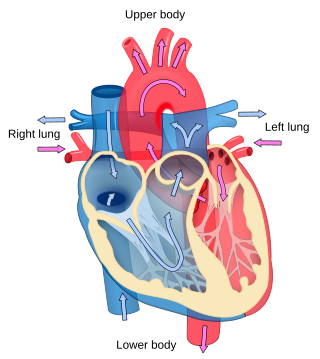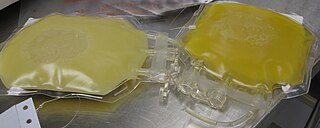Related Research Articles

Cardiology is the study of the heart. Cardiology is a branch of medicine that deals with disorders of the heart and the cardiovascular system. The field includes medical diagnosis and treatment of congenital heart defects, coronary artery disease, heart failure, valvular heart disease, and electrophysiology. Physicians who specialize in this field of medicine are called cardiologists, a sub-specialty of internal medicine. Pediatric cardiologists are pediatricians who specialize in cardiology. Physicians who specialize in cardiac surgery are called cardiothoracic surgeons or cardiac surgeons, a specialty of general surgery.

Coronary artery disease (CAD), also called coronary heart disease (CHD), ischemic heart disease (IHD), myocardial ischemia, or simply heart disease, involves the reduction of blood flow to the cardiac muscle due to build-up of atherosclerotic plaque in the arteries of the heart. It is the most common of the cardiovascular diseases. Types include stable angina, unstable angina, and myocardial infarction.

Angina, also known as angina pectoris, is chest pain or pressure, usually caused by insufficient blood flow to the heart muscle (myocardium). It is most commonly a symptom of coronary artery disease.

Atherosclerosis is a pattern of the disease arteriosclerosis, characterized by development of abnormalities called lesions in walls of arteries. This is a chronic inflammatory disease involving many different cell types, and driven by elevated levels of cholesterol in the blood. These lesions may lead to narrowing of the arterial walls due to buildup of atheromatous plaques. At onset there are usually no symptoms, but if they develop, symptoms generally begin around middle age. In severe cases, it can result in coronary artery disease, stroke, peripheral artery disease, or kidney disorders, depending on which body part(s) the affected arteries are located in the body.

Coronary artery bypass surgery, also known as coronary artery bypass graft, is a surgical procedure to treat coronary artery disease (CAD), the buildup of plaques in the arteries of the heart. It can relieve chest pain caused by CAD, slow the progression of CAD, and increase life expectancy. It aims to bypass narrowings in heart arteries by using arteries or veins harvested from other parts of the body, thus restoring adequate blood supply to the previously ischemic heart.

Peripheral artery disease (PAD) is a vascular disorder that causes abnormal narrowing of arteries other than those that supply the heart or brain. PAD can happen in any blood vessel, but it is more common in the legs than the arms.

Cardiovascular disease (CVD) is any disease involving the heart or blood vessels. CVDs constitute a class of diseases that includes: coronary artery diseases, heart failure, hypertensive heart disease, rheumatic heart disease, cardiomyopathy, arrhythmia, congenital heart disease, valvular heart disease, carditis, aortic aneurysms, peripheral artery disease, thromboembolic disease, and venous thrombosis.

Hypercholesterolemia, also called high cholesterol, is the presence of high levels of cholesterol in the blood. It is a form of hyperlipidemia, hyperlipoproteinemia, and dyslipidemia.

Coronary thrombosis is defined as the formation of a blood clot inside a blood vessel of the heart. This blood clot may then restrict blood flow within the heart, leading to heart tissue damage, or a myocardial infarction, also known as a heart attack.

The Framingham Heart Study is a long-term, ongoing cardiovascular cohort study of residents of the city of Framingham, Massachusetts. The study began in 1948 with 5,209 adult subjects from Framingham, and is now on its third generation of participants. Prior to the study almost nothing was known about the epidemiology of hypertensive or arteriosclerotic cardiovascular disease. Much of the now-common knowledge concerning heart disease, such as the effects of diet, exercise, and common medications such as aspirin, is based on this longitudinal study. It is a project of the National Heart, Lung, and Blood Institute, in collaboration with Boston University. Various health professionals from the hospitals and universities of Greater Boston staff the project.

A fatty streak is the first grossly visible lesion in the development of atherosclerosis. It appears as an irregular yellow-white discoloration on the luminal surface of an artery. It consists of aggregates of foam cells, which are lipoprotein-loaded macrophages, located in the intima, the innermost layer of the artery, beneath the endothelial cells that layer the lumina through which blood flows. Fatty streaks may also include T cells, aggregated platelets, and smooth muscle cells. Although fatty streaks can develop into atheromas, not all are destined to become advanced lesions.
The Nurses' Health Study is a series of prospective studies that examine epidemiology and the long-term effects of nutrition, hormones, environment, and nurses' work-life on health and disease development. The studies have been among the largest investigations into risk factors for major chronic diseases ever conducted. The Nurses' Health Studies have led to many insights on health and well-being, including cancer prevention, cardiovascular disease, and type 2 diabetes. They have included clinicians, epidemiologists, and statisticians at the Channing Laboratory, Harvard Medical School, Harvard School of Public Health, and several Harvard-affiliated hospitals, including Brigham and Women's Hospital, Dana–Farber Cancer Institute, Children's Hospital Boston, and Beth Israel Deaconess Medical Center.

Coronary ischemia, myocardial ischemia, or cardiac ischemia, is a medical term for abnormally reduced blood flow in the coronary circulation through the coronary arteries. Coronary ischemia is linked to heart disease, and heart attacks. Coronary arteries deliver oxygen-rich blood to the heart muscle. Reduced blood flow to the heart associated with coronary ischemia can result in inadequate oxygen supply to the heart muscle. When oxygen supply to the heart is unable to keep up with oxygen demand from the muscle, the result is the characteristic symptoms of coronary ischemia, the most common of which is chest pain. Chest pain due to coronary ischemia commonly radiates to the arm or neck. Certain individuals such as women, diabetics, and the elderly may present with more varied symptoms. If blood flow through the coronary arteries is stopped completely, cardiac muscle cells may die, known as a myocardial infarction, or heart attack.

A myocardial infarction (MI), commonly known as a heart attack, occurs when blood flow decreases or stops in one of the coronary arteries of the heart, causing infarction to the heart muscle. The most common symptom is retrosternal chest pain or discomfort that classically radiates to the left shoulder, arm, or jaw. The pain may occasionally feel like heartburn.
The Framingham Risk Score is a sex-specific algorithm used to estimate the 10-year cardiovascular risk of an individual. The Framingham Risk Score was first developed based on data obtained from the Framingham Heart Study, to estimate the 10-year risk of developing coronary heart disease. In order to assess the 10-year cardiovascular disease risk, cerebrovascular events, peripheral artery disease and heart failure were subsequently added as disease outcomes for the 2008 Framingham Risk Score, on top of coronary heart disease.

Soluble epoxide hydrolase (sEH) is a bifunctional enzyme that in humans is encoded by the EPHX2 gene. sEH is a member of the epoxide hydrolase family. This enzyme, found in both the cytosol and peroxisomes, binds to specific epoxides and converts them to the corresponding diols. A different region of this protein also has lipid-phosphate phosphatase activity. Mutations in the EPHX2 gene have been associated with familial hypercholesterolemia.
The BaleDoneen Method is a risk assessment and treatment protocol aimed at preventing heart attack and stroke. The method also seeks to prevent or reduce the effects of type 2 diabetes. The method was developed by Bradley Field Bale and Amy Doneen.

Erin Kathleen Donnelly Michos is an American cardiologist. She is an associate professor of Medicine and Director of Women's Cardiovascular Health at Johns Hopkins School of Medicine. Michos is also an Associate Faculty of the Welch Center for Prevention, Epidemiology and Clinical Research at Johns Hopkins, and has a joint faculty appointment in the Department of Epidemiology at the Johns Hopkins Bloomberg School of Public Health.
The Strong Heart Study is an ongoing cohort study of cardiovascular disease (CVD) and its risk factors among American Indian men and women. The original cohort began in 1984 with 4,549 participants ages 35–74 from 13 tribal nations and communities in Arizona, Oklahoma, North Dakota, and South Dakota. The need for specific ethnic and cultural understanding and sensitivities was recognized from the onset, so the study has a community-based participatory research (CBPR) model. Community members were involved in all stages of conception, design, and implementation of the research. Now in its seventh phase, the extensive research has led to many important findings about heart disease and unique risk factors in native populations. It is a project funded by the National Heart, Lung, and Blood Institute (NHLBI). The study maintains field centers in Oklahoma, North and South Dakota, and Arizona and a coordinating center at the University of Oklahoma Health Sciences Center.
April Perry Carson is an American epidemiologist. She is an associate professor of epidemiology and associate dean for diversity, equity, and inclusion at the University of Alabama at Birmingham School of Public Health. Carson is director of the Jackson Heart Study.
References
- 1 2 3 Schwaiger L. "Overview". Coronary Artery Risk Development in Young Adults Study. University of Alabama at Birmingham. Retrieved 2018-08-16.
- ↑ Gunderson EP, Lewis CE, Tsai AL, Chiang V, Carnethon M, Quesenberry CP, Sidney S (December 2007). "A 20-year prospective study of childbearing and incidence of diabetes in young women, controlling for glycemia before conception: the Coronary Artery Risk Development in Young Adults (CARDIA) Study". Diabetes. 56 (12): 2990–6. doi:10.2337/db07-1024. PMC 2952440 . PMID 17898128.
- 1 2 3 Rhodes D (2016-05-02). "Landmark heart disease study marks 30 years of research". Chicago Tribune. Retrieved 2018-08-16.
- ↑ Friedman GD, Cutter GR, Donahue RP, Hughes GH, Hulley SB, Jacobs DR, Liu K, Savage PJ (1988). "CARDIA: study design, recruitment, and some characteristics of the examined subjects". Journal of Clinical Epidemiology. 41 (11): 1105–16. doi:10.1016/0895-4356(88)90080-7. PMID 3204420.
- ↑ "Participating Institutions". Coronary Artery Risk Development in Young Adults Study. University of Alabama at Birmingham. Retrieved 2018-08-16.